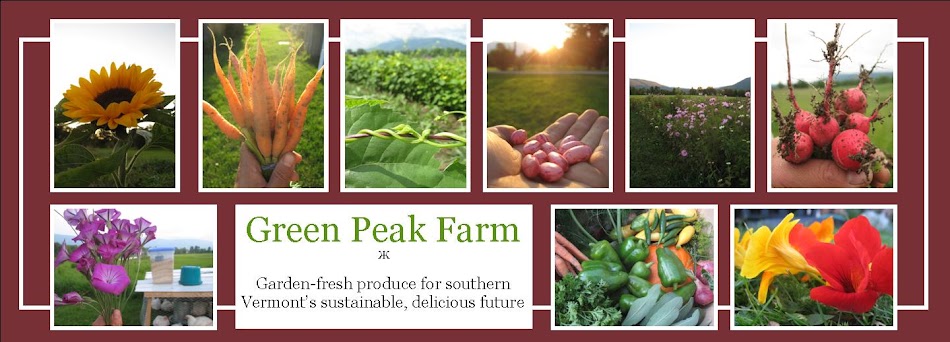
August 11, 2009
With two weeks of sun to ring in August, I’m resisting the feeling that summer is coming to a close. The Canada geese catch me off guard every now and then, beginning their southward migration to warmer climes (but, but… summer just got here!) The deer are becoming more adventurous in their browsing lower down the hill (goodbye, beets, swiss chard, and some storage carrots.) The last round of late-fall harvest crops (more cabbage, leeks, new chard, kale, lettuce) has been freshly-transplanted. Tomatoes are still holding out on us, and though we’ve been fortunate to not have gotten hit by this season’s devastating late blight, they were hit by another unusual virus spread by beet leafhoppers—and a hundred and fifty plants had to be pulled out and destroyed. The potatoes went down almost overnight with somekindofsomething blight. The good news is that, as you know, the cucumbers, squash, cabbage, broccoli, soybeans, and so many other crops have done really well. Tomatoes should be in your boxes next week, as well as one of my favorites, the picky romanesca cauliflower. Heads are fractals arranged according to a fibonacci sequence—pyramids upon swirling pyramids, they’re pretty stunning. I’ve been tempted to shellac ‘em instead of eating them, but resisted. As yet.
In watching The Real Dirt on Farmer John (thanks, Jake!) I’ve been thinking a lot about how fast our modern agricultural system has developed and sprawled. It’s incredible to me that only in the past fifty years have we Americans, in general, been farming the way we do. The Green Revolution, which resulted from a surplus of nitrogenous chemicals leftover from production of explosives in WWII, has come about within our parents’, or our grandparents’ generations. The collapse of the small, diversified family farm is a new idea, as is the consumption of highly-processed, well-traveled, high-calorie, low-nutrient food. Obesity statistics by the CDC are astounding:
Since the mid-seventies, the prevalence of overweight and obesity has increased sharply for both adults and children. Data from two NHANES surveys show that among adults aged 20–74 years the prevalence of obesity increased from 15.0% (in the 1976–1980 survey) to 32.9% (in the 2003–2004 survey). (http://www.cdc.gov/obesity/data/index.html)
Obese children and adolescents are more likely to become obese as adults.3, 4 For example, one study found that approximately 80% of children who were overweight at aged 10–15 years were obese adults at age 25 years. (http://www.cdc.gov/obesity/childhood/index.html)
In a short period of time, we have managed to drastically and literally reshape America, as well as a large part of its cultural identity. The movie is a fascinating portrayal of a bright young man raised on his family’s farm in rural Illinois, who heads off to college, has his brain scrambled up a bit experimenting with the excitement of college in the ‘60s, and then tries to reconcile the two worlds he is irrevocably tied to. After and amidst struggles with depression, financial insolvency, community harrassment, and loss of family and friends, he comes to organic agriculture based on the CSA model while also supporting a diverse mix of production, education, employment, apprenticeships, and general merrymaking. Farmer John, our definitely kooky protagonist, makes a fair amount of mistakes along the way, but I think the film is most successful in exactly that—the portrayal of the very human side of his agricultural exploits. In many ways, he is an open, amplified, exuberant display of the emotions that are exactly those repressed by the good old midwestern values of emotional conservatism and expression. In being the perfect opposite of his fellow midwestern farmers (flamboyant, moody, suffering,) he actually portrays them better than anyone could imagine. And he sticks with it. This is where food comes from.
Another commentary on the flaws of our modern system is an interesting letter written by Eliot Coleman, and published by the Grist environmental newssource.
http://www.grist.org/article/2009-08-07-debunking-meat-climate-change-myth/
Rarely do complex problems arise from a single point of error, and it is a multi-faceted issue that is ours to handle. Untying the knot of responsibility that connects our nation’s food, farmlands, culture, government, businesses, economy, and health is a daunting task, and that’s exactly what the corporational lobbyists want us to think. They’re “too big to fail.” Supporting your local farmers is one clear, short-term, and good way to begin the paradigm shift that is inevitable, and as great as that feels, we need to bring this to a larger playing field. Exactly how, I am not quite sure. Supporting local farmers,letters, votes, and supporting organizations like Rural Vermont (http://www.ruralvermont.org/) are good ways to start, but beyond that? Who’s got ideas?
Here’s what’s in your share this week:
red cabbage
purple, green, wax, and striped beans
lettuce head
bunch of kale
summer squash
cukes – slicers and picklers
a handful of cherry tomatoes
serrano hot peppers
bell peppers
yellow onions
bag o’ basil
fennel bulbs
Red Norland potatoes
fava beans (broad and fat)
edamame soybeans (small and hairy)
To eat favas: shell the beans and steam for 2-4 minutes, dash with lemon juice, olive oil, and salt, then bite into white bean casing, pop the green inner bean into your mouth, and enjoy!
To eat edamame: rinse the pods, then steam for 3-5 minutes. Sprinkle with salt, pop the beans outside of their hairy pods casings, and eat just the green beans inside. These make a great, healthy, unprocessed after-school snack—blanch and freeze extras for later, or serve with your next stir-fry or sushi dinner to up the aunthenticity!
Enjoy!
Mego

No comments:
Post a Comment